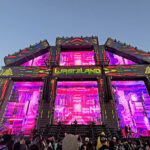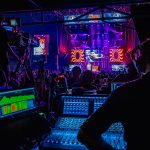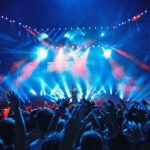Ever since Bob Dylan “plugged in” at The Newport Folk Festival in 1965, the annual music event has been synonymous with both music tradition and innovation. Although Dylan once jokingly referred to the electrified style he helped to pioneer as “Folk rot,” roots or Americana music hasn’t disintegrated in the last 50-plus years. Instead, it has fused somewhat with rock and other genres to create a hybrid beast.

The Newport Folk Festival, which ran from July 22-24, and its sibling, The Newport Jazz Festival (July 29-31), are among the oldest annual music events in America. Yet, despite Newport’s storied history, these festivals are far from static. Producers are among the first to book emerging artists, bucking the trends while representing popular music’s revolutionary twists and turns.
The 2016 Folk Festival boasted marquee names (i.e. Elvis Costello, Patti Smith, Graham Nash, Ryan Adams, Norah Jones, Violent Femmes) along with critically acclaimed and cutting-edge acts such as Ray Lamontagne, Alabama Shakes, Edward Sharpe and the Magnetic Zeros, Lady Lamb, Son Little (a.k.a. Aaron Livingston), Julien Baker, Middle Brother, Freakwater, U.K. sister act The Staves and River Whyless, among others.
Son Little’s genre-bending music, which blends gospel, psychedelic rock, R&B, soul and blues, exemplifies the kind of musical diversity the Folk Festival has been promoting for decades.
“At first, I was a little apprehensive to play there, wondering how my music would be received,” says Little, who made his Newport Folk Festival debut in July 2016. “Some people think of folk music as somebody strumming away on an acoustic guitar, singing about a farm or a train. It is that, but it also reflects the experiences of life of the people who play it, write it and share it. It’s cool to have something as well established as Newport Folk embracing that idea.”
Similarly, the Newport Jazz Festival, founded in 1954, hosted a variety of artists from across the jazz spectrum, including Galactic, Tierney Sutton, The Bad Plus, The Hot Sardines, John Scofield and the Joe Lovano Quartet, Kenny Barron Trio, Angélique Kidjo, Charles Lloyd New Quartet and others. As is customary, a Friday evening performance, the only truly nighttime concert presented during the two-week festival run, was staged at the Newport Casino’s International Tennis Hall of Fame (ITHF), site of the original Jazz Festival. This year, the ITHF hosted Chick Corea Trilogy and Grammy-winning soul/jazz man Gregory Porter.
“It’s not for us to define what this music is,” says Jazz Festival producer Danny Melnick. “We present a very diverse style of music at the festival for that reason. It’s not a swing festival. It’s not an avant-garde festival. It’s not a funk festival. It’s not a Bebop festival. It’s everything.”

Ghosts Upon Ghosts
Newport Jazz and Folk Festivals were not always the definitive and iconic events we think of today. Crowd control, among other issues, forced founder/producer/promoter George Wein to stage the Jazz Fest outside Newport in the early 1970s. Wein was eventually wooed back to the city a decade later, but not before he headed south, producing the Jazz Fest in New York City. (By the same token, the Folk Festival ran through the early 1970s before shutting its doors for nearly 15 years. It was resurrected in the late 1980s.)
Newport was happy to see Wein return, but floated a few conditions. For one, outdoor concerts would need to take place during daytime hours only. Wein agreed and was urged to consider Fort Adams State Park as an alternative site for the Jazz Festival. As it turns out, the suggestion was nothing short of genius. In the intervening years, the festivals have sent tourism skyrocketing, making these concerts as “New England” as intermittent rain, Red Sox baseball, Maine lobster, sailing and sunshine.
“It’s an idyllic location,” says Folk Festival producer Danny Melnick. “[Fort Adams State Park] juts out into the water — and the bay is a spectacular site for the audience and artist.”
Guitarist and West African native Lionel Loueke tells PLSN: “The Newport Jazz Festival was, and is always, one of the great live performance experiences in terms of playing in a big venue while still having the feel of an intimate club vibe,” says Loueke. “Playing on my latest project [in 2016], with my Aziza band mates [Dave Holland, Chris Potter, Eric Harland], is one of the best musical experience I have had in a long time.”
The location’s near spiritual and welcoming climate, along with the impressive and often imposing sight of Fort Adams (the 19th Century stronghold named after U.S. President John Adams), keeps many visitors spellboundSome compare the seascape of Rhode Island’s concert jewel with stunning environmental wonders and man-made vistas one would typically find at venues such as Colorado’s Red Rocks, Washington State’s The Gorge Amphitheatre, or Tennessee’s Cumberland Caverns (PLSN, Oct. 2013).
Yet there seems to be a special kind of electricity in the air at Newport. Most agree the setting is beautiful, but there’s also something spooky about the atmosphere surrounding the festivals’ four main performance stages (i.e. Fort, Quad, Harbor and Museum stages for Folk; Fort, Quad, Harbor and Storyville for Jazz.)
“Jim James of My Morning Jacket, a token family member, as we like to say,” says Jay Sweet, producer of the Folk Festival, “performs at [Newport] because he feels like he’s playing upon ghosts upon ghosts upon ghosts upon ghosts.”
“It took me a few minutes to understand what was going on, and that I was in the barracks of this fort,” adds Son Little, who performed at the Harbor Stage on Sunday, July 24. “It’s surreal.”

They Build This City
Newport stands apart from even the most extraordinary concert haunts in America, due in no small measure to the unique staging challenges the festivals present. For starters, unlike so many other high-profile venues around the country, components of the infrastructure must be composited virtually from scratch, every year. Because Fort Adams is a state park, nothing permanent, of any major consequence that is, aside for the brick masonry of the coastal citadel stays in place year over year.
Secondly, the festivals operate on generators that are strategically placed around the property to cut down on noise pollution. Long cables for power and communication systems are snaked up and over a 30-foot-high, 25-foot-thick protective wall enclosing the Quad stage, crisscrossing the site.
“There are a lot of challenges to building the stage at the Fort, especially inside the Quad, where you can’t get semis or trucks,” says Sweet, who began booking the festival in 2008, prior to stages being set up in the Quad. “Everything is done hand-over-hand. It’s a pretty impressive feat. The snow fencing, Mojo Barriers, recycling bins — it’s all done the old fashioned way: straight up manpower.”
Wurzelbacher Staging & Construction Inc. have done the builds for both festivals for decades. East Coast Lighting & Production Services (ECLPS), which have lit the Newport festivals over a 20-year span, returned to supply the lighting, lighting design, rigging and motors for the 2016 shows. New Orleans-based Event Productions provided video. With a little tweaking and re-skinning, the very same platforms and structures built for the Folk event were utilized for the later Jazz Festival.
By now, organizers have the site build down to a science. Along with the use of lasers, members of the crew are issued step-by-step guidebooks containing the exact measurements of each stage. Of course, site surveys are completed prior to the events, noting any changes in the vicinity of Fort Adams State Park that could raise any potential issues for the crew. Organizers are also well aware that they are guests — friendly guests, but visitors nonetheless. Producers must arrive at, temporarily commandeer, and then vanish from the public space without a trace.
“It’s like building a city and then tearing it down every year,” says Sweet.

Modern Technology
Modernization of the festivals happens in many different ways and on many different levels. In 2016, Newport took bold new steps, upgrading its tech and introducing moving lights and LED fixtures around the festival site.
“We wanted to update the lighting to match the energy level of the modern acts that have been booked at the festivals over the past few years,” says Bob Morrissey, president of ECLPS. “At the same time, we were cognizant of the heat levels on the main stage [Fort Stage] and in the secondary stages that were under tents. For this reason we decided to use as many LED automated fixtures as possible on all the stages.”
“The Folk Festival is certainly morphing,” says lighting designer Nate Almeida of ECLPS. “Bob [Morrissey], our boss, motivated us to say, ‘We can put programmers in the tents with running lights. Let’s not just throw up a wash, see the band play and then leave. Let’s make more of a show.’ We had programmers and lighting people inside of each area to do that.”
“This was the first year that we started to experiment a bit more with things other than front lighting,” says lighting crew chief Joe Nieuwendyk of ECLPS. Artists and organizers, he notes, “didn’t like it when we were in the faces [of performers] with the LEDs. We had to really focus on the stage and not blind people, especially as concerns the Jazz Festival. We still go with the conventional PARs downstage [on the main stage]. But upstage and mid-stage, we had 14 Robe 1200s and four Patt 2013s, just for certain looks.
“They used to film and broadcast the performances,” Nieuwendyk continues. “The main stage had 12 HMI 1200s. When they stopped filming the festival, I spoke with the production manager, Bob Jones, at the time, and I said that the stage is in darkness. A lot of times what happens is, a part of the stage is in sun and another is in darkness. To help solve this problem, we were using shadow busters. The same in all the tents. But because more and more people seem to like standing outside the tents, sunlight comes in and you can’t see anything inside [the tent]. Moving to LEDs has helped tremendously.”
Tungsten-equipped Robe Patts have been used extensively by designers, in part, because of its sleek, classic look. A similar application was undertaken for the Jazz and Folk Fests. “The light isn’t just being functional,” says Almeida. “It’s a scenic element, too.”
For the main stages of the festivals, lighting is operated from under the stage. All focus work is done at night. “Some of what is done with the lighting is spontaneous,” says Nieuwendyk. “There is no front-of-house [FOH] position. For the Folk Festival there are so many consoles at the FOH tent that you have no area to set up a [lighting] desk, anyway. We have to do work underneath the stage. A couple of bands had their own LDs, and they sort of knew the music.”
Auxiliary tents located around the festival grounds were also illuminated. For these spots, ECLPS tapped Elation Quad PARs, Robe 100 and 600 LEDBeams and CycFxs. For the Toyota Prius tent, “we had some ColorBlast lighting along the tent skin,” says Nieuwendyk. “Some white PAR 38s were scattered around and lighting the cars, giving them a bit more ‘umph.’ As I said, these are huge tents, but they are completely open on the sides. It’s pretty bright in there.”
ECLPS allowed themselves a couple weeks of prep for the festivals. Time and forethought were especially important for the 2016 concerts. “We were not on autopilot,” says Almeida. “We came up with a whole new design this year. If you’ve done something one way for 20 years — and now we are going to change it — there needs to be more of a thought process. We’re going to need to talk with the staging company to work out logistics about where things are placed, where they need to hang on temporary structures and such. It seems like everybody works closely on every aspect to get the job done.”
Balance
Through the talent booked every season, the use of lighting technology and the work both onstage and off (not to mention under the stage), Newport Jazz and Folk Festivals strike a rare balance between tradition and innovation.
“It’s amazing that these people can sing about change and injustices within — and with their back up against — a military installment,” says Sweet. “It’s a cool dichotomy.”
“People died defending this place, in which you are putting on a concert,” says Almeida. “There’s a lot of history attached to these shows.”


